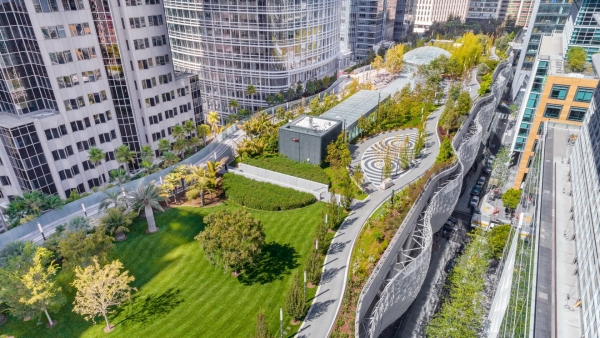As we reconsider the role of the office in our everyday lives, there’s a shift towards viewing it as a multifaceted experience rather than a physical place. Hybrid workers expect time spent in the office to be purposeful – as enriching and exciting as living in a great city, soaking up culture, or visiting a live event. How will design respond?
UK workplace strategy company Unispace suggests that activity-based working – which encourages agility but is still carried out in a fixed place of work all day, every day – might evolve into experience-based working. In a blog post, it describes that in the latter model, work is carried out ‘wherever it is most productive’ and people ‘choose spaces which have been curated according to the required experience’. Employees are only in the office for as long as it takes to complete a certain task.
Those experiences should be designed around the three main reasons it believes people spend time in the office: problem-solving (25 per cent), innovation (30 per cent), and community (45 per cent). That might mean: ‘libraries, side-by-side tables, mega-tables, and VR/AR spaces’ for problem-solvers’; ‘theatres, flexi-rooms, huddle spaces, maker labs, think caves and immersion rooms’ for innovators’; and ‘a town hall space, games rooms, café spaces, vegetable gardens, customer experience centres, BBQ pits and a brand zone’ to establish community.
The city as corporate campus
Though it might be tempting to stuff offices with amenities to cover all types of working, The Experience Book co-author Adam Scott stresses that one building does not have to accommodate everything. The future office can operate as a network of spaces including those it does not own. ‘Workplacemaking’ is the term global engineering firm Arup and Irish real estate company IPUT use to describe a greater overlap of civic and corporate space in their 2020 report Making Place. ‘It feels like people are locked into the possibilities that are right in front of them: work from home or work from the office,’ Anthony Townsend, urbanist in residence at Cornell Tech, contributed. ‘We need a toolkit – more possibilities – to break out of this binary thinking.’
The report identifies six types of urban space that could support different working experiences. These are watering holes (for people to meet and linger); street classrooms (for informal knowledge exchange), cultural canvases (shaped and programmed by people and communities), mind labs (encouraging group innovation); mind gardens (supporting individual thinking); and connective tissue (routes that encourage active travel). These can be within commercial buildings or in the places between, blurring the boundaries between work and the city. Vancouver’s Alley-Oop, a public games court in between two commercial buildings, the ground floor gallery of Arup’s London office, the steps of the Met Museum, the free study desks in the British Library, and the lush landscaping around 555 Market Street in San Francisco and New York’s High Line, are all places it suggests form a tapestry of working experiences.
The shared office building
In return, the office should increasingly accommodate civic needs. In line with the growth of sharing economies and societies, commercial buildings can contribute to local neighbourhoods by extending use into the evening and weekends. So far, it’s mostly the ground floor and rooftops of office buildings that are open to the public – like Woods Bagot’s National Australia Bank at 700 Bourke Street in Melbourne – but the relationship between companies and communities could go much further. Director of UK architecture practice TP Bennett Christopher Webb said at Bisnow’s Building for the Future event last month: ‘I really struggle to see prime office space empty Mondays and Fridays when we’ve got schools and community groups that can’t find space. We need to join the dots and use terraces for community allotments or boardrooms as teaching facilities.’
This broadened user base might become more of a reality as companies continue to further their corporate social responsibility strategies. Purpose has been a business buzzword in 2022. Research shows leaders making it a core part of their culture see net gains of 25-40 per cent in productive employee behaviour and retention. Author and speaker Puneet Gaur wrote for Forbes: ‘The idea that society should be the primary stakeholder when you make decisions in your organization. . .helps build empathy in employees, creates emotional intelligence in leaders and cultivates a culture of servant leadership. Younger employees. . .can be highly engaged and productive for the right employer, they also won’t stick around if they don't feel the company reflects their values.’
_______________________________________________________________________________________________________________________________________________________
▪ Source: FRAME|https://www.frameweb.com/article/work/what-does-it-mean-to-design-the-workplace-as-an-experience
▪ Words: RIYA PATEL
▪ Photography Credit: ©JASON O'REAR


